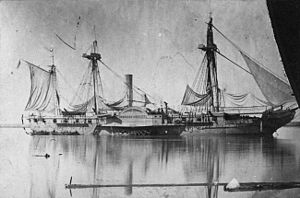Home Squadron
| Home Squadron | |
|---|---|

USS Mississippi in 1863, she served as the flagship of the Home Squadron during the Mexican-American War.
|
|
| Active | 1838-1861 |
| Country |
|
| Branch |
|
| Type | Naval squadron |
The Home Squadron was part of the United States Navy in the mid-19th century. Organized as early as 1838, ships were assigned to protect coastal commerce, aid ships in distress, suppress piracy and the slave trade, make coastal surveys, and train ships to relieve others on distant stations. It was discontinued in 1861 after the outbreak of the American Civil War, when the Union blockade forced a reassignment of ships to close off Southern ports.
During the Mexican-American War the ships of the Home Squadron, commanded by Commodore David Conner, USN fought in several engagements against Mexican forces. Many of the Home Squadron vessels were attached to vice commander Commodore Matthew C. Perry's Mosquito Fleet which was involved in the battles of Tuxpan, Tabasco, Villahermosa and Veracruz. No ship-to-ship combat occurred though several merchant vessels were captured, the Home Squadron primarily operated against Mexican coastal forts and artillery batteries.
Since the Mexican War of Independence ending in 1821, Mexican liberals - A political party which evolved from the Masonic Lodge of the York Rite created by Joel R. Poinsett who was an American Diplomat sent by President James Monroe to secretly propose the purchase of the northern provinces from the First Mexican Empire; and the conservative party, which as its name indicates - Its principal objective was to preserve the traditions and customs of the nation, were constantly in conflict at each other throughout the first decades of the existence of Mexico. The continuous friction led to a major civil war known as the Reform War from 1858 to 1860 and political instability, which the U.S. government under James Buchanan saw as a great opportunity to further expand the U.S. territory limits southwards (after the acquisition through war of California, Arizona, New Mexico, Nevada, Utah, most of Colorado, south Wyoming, and a fraction of Kansas and Oklahoma. For this reason and based upon the Doctrine Monroe, the U.S government sent an emissary to discuss with Juarez's liberal party the possibility to ceed the Baja California peninsula to the United States, which he promptly accepted in exchange of diplomatic, economic and military support to counteract the conservative power that at that point, had the full support of the majority of the Mexican people, and was in control of the entire country with the exception of the cities of Morelia and Veracruz.
...
Wikipedia
